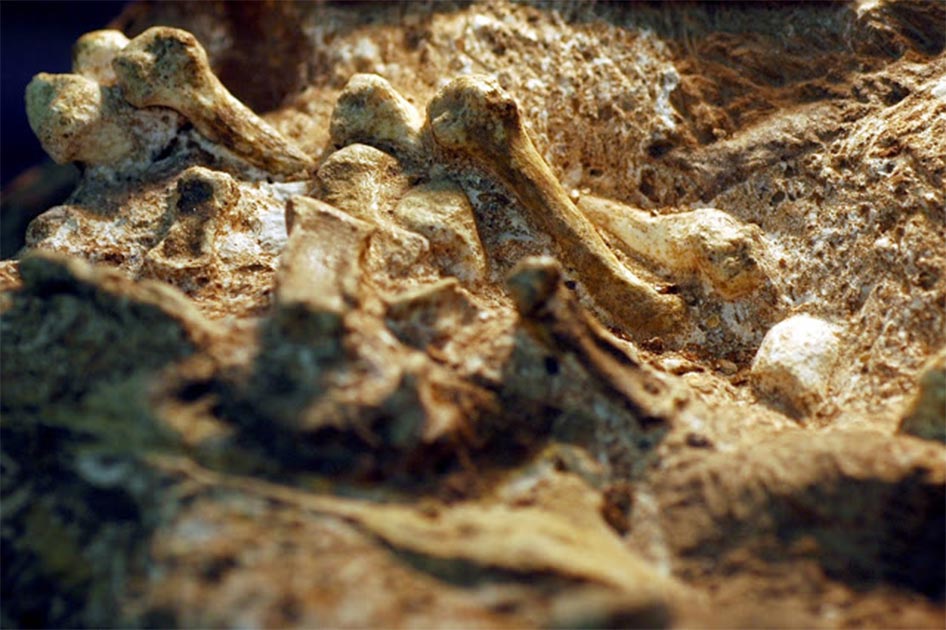2 Million-Year-Old Human Ancestor Had A Grip Just Like Us
Inhabiting what is now modern-day South Africa, an ancient human ancestor, Australopithecus sediba, that lived two million years ago had hands that might have enabled it to carry out some movements like modern humans, a new study suggests.
Dr Christopher Dunmore, who led the new research project, the results of which were recently published in the journal Nature, Ecology and Evolution, said his team anthropologists from the University of Kent analyzed the two million year old hominin's well-preserved hand bones revealing it was “a hybrid” that had climbed trees like its predecessors, but the bone structure indicated that it could also perform precise “human-like movements”.

The fossilized hand bones of Australopithecus sediba. (Image: © Dunmore et al. University of Kent)
A Two-Million-Year Old Multi-Tool
The new findings from the knuckles of Australopithecus sediba “paints a complex picture of how human ancestors slowly ditched a life in the trees for a ground-based existence” and in particular the research showed the thumb knuckle was slightly different from other primitive hominins, including other Australopithecus species. The thumb was, however, found to be more consistent with human-like manipulation, the researchers say in their paper.
Dr. Dunmore said that internal bone structures are shaped by repeated behaviors during life and that his team's findings not only reveal how this species lived, but it also can support further research into the internal structure of hands in relation to stone tool use and production and when ancient human ancestors moved away from climbing trees. Furthermore, the findings of this research project will further studies into how other ancient hominin species moved around, and to what degree tree climbing was a part of their day to day activities.

The site where the A. sediba remains were found, in Mamapa, South Africa. (Image: © Dunmore et al. University of Kent)
Observing Our First Steps
Previous research has found that some early species spent more time on the ground and over time slowly began walking on two legs, as opposed to four, known as bipedalism, and it was this that allowed modern humans to evolve. It is thought that bipedalism may have brought about the sharing of food and resources among early communities. According to a report in the Daily Mail, walking on two legs was already common among some early hominins, with estimates on the emergence of bipedalism dating back to up to six million years ago.
Anthropologists and archaeologists maintain bipedalism is resultant from an expanding brain capacity and while modern humans enjoy heightened IQs, conversely, it also means they have much more difficult giving birth while other ancient human ancestors had far less difficulty, a recent study found.
Last September I wrote an Ancient Origins article about a team of scientists who published a paper on PLOS ONE looking at how an ancient human relative gave birth on its own and had a painless and quick experience compared to today’s mothers.
- Ancient Childbirth Beliefs and Rituals Thought to Protect Mother and Child
- Where Royals Were Born: The 1,000-Year-Old Kukaniloko Birthing Site of Hawaii
- Birthing Trauma Comes from Two Million Years of Walking Upright

Malapa Hominin 1 (MH1) left, Lucy (AL 288-1 (Center), and Malapa Hominin 2 (MH2) right. (Image compiled by Peter Schmid courtesy of Lee R. Berger, University of the Witwatersrand. (CC BY-SA 3.0)
Great Grips, And Pain Free Child Births
The paper’s lead author, Dr. Natalie Laudicina of the Department of Anthropology at Boston University, Boston, Massachusetts, created a 3D model of a female Australopithecus sediba's pelvis, and with it they were able to reconstruct its birth process. It was found to be consistent with other hominin species, including modern humans, in that the fetus entered the pelvic inlet in a transverse direction, however, a fetus in the ancient species did not require several rotations in the birth canal causing much less discomfort.
This team of researchers also determined that adding to the reasons modern human childbirth can be a difficult, painful and a lengthy process, compared to Australopithecus sediba who lived around 2 million years ago, was that the ancient species had much wider birth canals. And not only was the road to birth straighter and much wider in accident times, but adding to the difficulties, pains and duration of modern births, is the fact that today’s infant heads are much bigger. So while pelvises became narrower as humans began to walk upright, birthing canals tightened up, and heads swelled, all leading to the trials and tribulations suffered by today’s pregnant mothers.
The report, ‘The position of Australopithecus sediba within fossil hominin hand use diversity’ is available on Nature magazine, DOI: https://doi.org/10.1038/s41559-020-1207-5.
Top image: A. Sebida hand bones show this human ancestor’s grip was similar to a modern human’s. Source: Peter Schmid, courtesy of Tracy Kivell/University of Kent
By Ashley Cowie
References
Dunmore, C.J., Skinner, M.M., Bardo, A. et al. The position of Australopithecus sediba within fossil hominin hand use diversity. Nat Ecol Evol (2020). https://doi.org/10.1038/s41559-020-1207-5




















Comments
Walking upright freed the hands to carry tools and joints of (scavenged?) meat. Is this a serendipitous by-product of bipedalism or one of the main drivers behind the change in the first place?